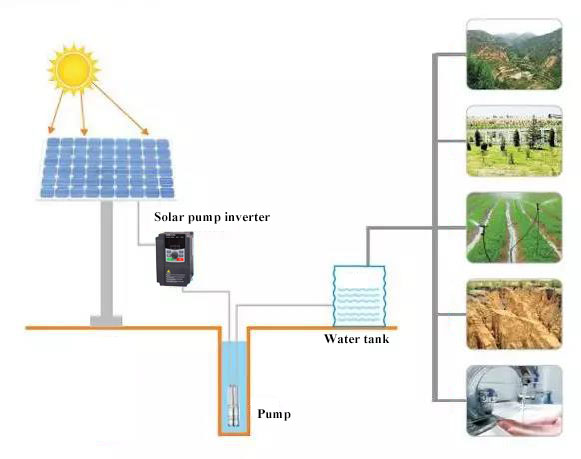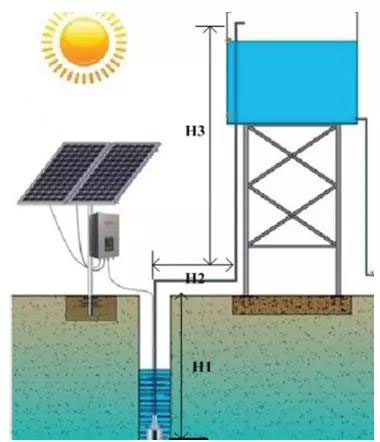With the development of solar power technology, and people's comprehensive considerations and strict requirements for water consumption, water quality, water supply system reliability, and environmental protection, the solar water pumping system has increasingly become the preferred solution to water use because of its easy installation, no labor guard, low cost and zero carbon emission and so on.
Main constitutions of solar water pump system
The solar water pump system, or PV pumping system, is mainly comprised of solar panels, a solar pump inverter, a water pump, a pipeline, and a water tank. In this system, the storage battery is omitted, and the water pump is directly driven, which has high reliability and reduces the investment cost.
1. Solar cell module
 The solar cell module is a solar power generating device that directly converts solar energy into direct current electrical energy. Several solar panels in a series-parallel connection constitute the solar cell array. It absorbs solar radiation, and transforms it into electricity energy, to provide the power source for the entire water pumping system.
The solar cell module is a solar power generating device that directly converts solar energy into direct current electrical energy. Several solar panels in a series-parallel connection constitute the solar cell array. It absorbs solar radiation, and transforms it into electricity energy, to provide the power source for the entire water pumping system.
According to the different requirements of the user to power and voltage, the solar cell module can be done for individual utilization or several solar cell modules can be connected in series (to meet the voltage requirement) and parallel (to meet the current requirement), thus forming a power supply array to provide greater power.
The generating capacity of the solar cells increases proportionally with the increase in the intensity of sunlight. It shows a slight decrease as the temperature of the surface of the component rises. As the temperature changes, the current, voltage, and power of the solar cell will also change accordingly, so the negative temperature coefficient of the voltage must be considered when designing the solar panel in series.
2. Solar pump inverter
The direct output of solar cells is generally 12V DC, 24V DC, and 48V DC. To provide AC energy to the devices or appliances, it is necessary to convert the direct current energy generated by the solar power system into AC electric energy, so a DC-AC power inverter is required. The DC-DC inverter is also needed in some cases when a load with multiple voltages is required, such as converting power from 24V DC to 5V DC (note that it is not a simple buck). The solar pump inverter plays such a role.
The solar pump inverter is the most important equipment in the photovoltaic water pumping system and the soul of the system. The inverter controls and regulates the operation of the PV pumping system, converts the DC power generated by the solar cell array into AC power, drives the water pump, and adjusts the output frequency in real time according to the change in the intensity of the sunlight, realizes the maximum power point tracking, and maximizes the utilization of the solar energy.
3. Water pump, pipeline and reservoir
The main task of a water pump, pipeline, and reservoir is to pump, deliver, and store water.
The water pump is driven by the three-phase AC motor, pumping water from the deep well or river and lake, injecting it into the reservoir or pool, directly accessing irrigation systems and fountain systems, and so on. Pumps are mainly classified into two categories according to their working principles: centrifugal pumps and volumetric pumps. Piston pumps, gear pumps, and screw pumps are all volumetric pumps. Centrifugal pumps work because of the centrifugal force, and the typical structure is an impeller and volute structure. The volumetric pump works because of the movement of the enclosed space. It loads liquid into the space of the entrance port and then moves from the entrance to the outlet to release liquids. Such work repeats in the cycle. The volumetric pump has many structural forms, and the more common types are vane pumps, gear pumps, screw pumps, plunger pumps, and on on.
In the photovoltaic water pumping system, the choice of pump is critical, which directly affects the economics and stability of the entire system. The most commonly used solar water pump in the PV water pumping system is a submersible pump, characterized by a wide application range and wide speed regulation range, which can increase the daily working time and water output of the solar water pump system.
Typical design of solar water pump system
Different regions and customers have different demands, so different designs must be carried out for different demands. Therefore, the premise of the design is to give the customer the most optimized solution based on fully understanding the customer's needs, to meet the users’ demand needs to the greatest extent.
1. Model selection procedure
- Confirm the head and flow of the water pump
The head is the vertical distance from the pump water inlet to the outlet, and the flow is the daily water consumption. - Confirm the power of the water pump
It depends on the head, flow outlet diameter, and so on. - Confirm the inverter
The power of the inverter is 1.1-1.3 times the water pump motor power. - Confirm solar panel capacity
The power of solar panels is 1.3-1.5 times of the inverter power. - Selection of the cable specification
It depends on the connection distance between the inverter and the water pump
2. Obtain user demand - Daily water demand, head, and diameter of the well
Before configuring the solar water pump system, it is required to know the customer information in detail to give an effective solution.
For instance, the information of a customer that we should understand before as follows:
- The well depth is about 55m, the head is about 48m, and the well diameter is about 200mm.
- Need to irrigate 5 hectares. The entire irrigation period requires about 27000 m3 of water and irrigates for a continuous six months.
- The local average sunshine is about 5 hours per day.
 About the head of the water pump, the following is a brief introduction about it.
About the head of the water pump, the following is a brief introduction about it.
The head refers to the height at which the pump can lift water, usually expressed in H, and the unit is m.
Pump head = static head + horizontal delivery distance + loss head
The static head refers to the altitude difference between the suction point of the pump and the high control point. For example, by pumping water from a deep well and sending it to a high water tank, the static head refers to the altitude difference between the water suction point in the well and the water tank at the high point. As shown in the figure, the static head is H1+H3, and the horizontal delivery distance is shown in Figure H2. When the head is generally calculated, the head is counted as 1m for every 10m in the horizontal direction. The loss head is usually 6% to 9% of the net head, such as water pipe elbow, waterhead, and so on, which is generally 1~2 m.
Now see the specific selection of the solar water pump system configuration.
1. Solar water pump
According to the known head and flow, a suitable water pump can be referred to in a reversed manner: for example, 1000 m3 of water is pumped in 300 days, the local sunshine is 3.5 hours, and the system efficiency is 0.8.
Head: 110m
Flow: 1000/(300*0.8*3.5)= 1.19 m3/h
Pump selection: pump motor power 1.5kW, flow 1.2m3/H, head 115m.
2. Solar pump inverter
Generally, it is better to select an inverter that is larger than the water pump one size in the specification. The 1.5KW water pump is equipped with a 2.2KW solar pump inverter at least.
3. Solar panels
Generally, the solar panel power to be chosen is 1.3-1.5 times of the water pump power. Here is 1.5*1.4=2.1KW. The working voltage of the solar pump inverter is 200V-360V. It can select the 280W solar panel, 8 pieces connected in series, with a total power of 2.24kW.


Pumping Machine (submersible) 1.5H capacity
Thank for you prompt & adequate response.
Temitope (+2348038028065)
aremu_temitope@yahoo.com
Thanks